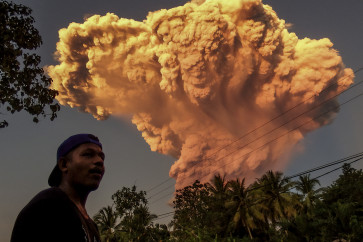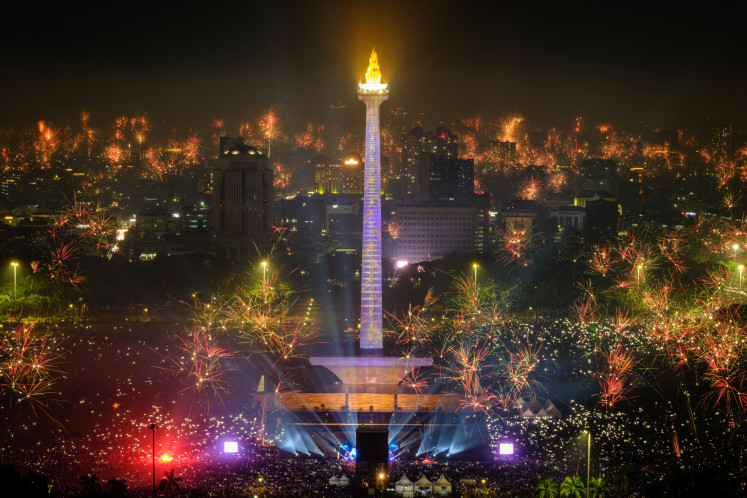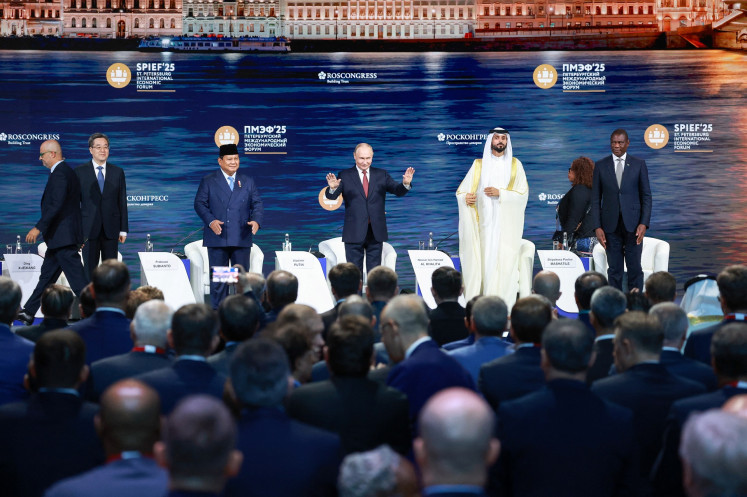Popular Reads
Top Results
Can't find what you're looking for?
View all search resultsPopular Reads
Top Results
Can't find what you're looking for?
View all search results'Pencak silat' in sculptural form
On the move: Visitors admire exhibited works on display at the Expression of Feeling and Shape in Pencak Silatâs Movement exhibition at Taman Ismail Marzuki cultural center in Central Jakarta
Change text size
Gift Premium Articles
to Anyone

O
span class="caption">On the move: Visitors admire exhibited works on display at the Expression of Feeling and Shape in Pencak Silat's Movement exhibition at Taman Ismail Marzuki cultural center in Central Jakarta. The exhibition runs until Aug. 15.
Preserving a culture can be done in many ways ' one creative method is by marrying sculptural art with Indonesian traditional martial art form pencak silat.
Various styles of pencak silat have been reinterpreted by 26 sculptors in more than 40 works for the Ekspresi Keindahan Rasa dan Bentuk dalam Gerakan Pencak Silat (The Expression of Feeling and Shape in Pencak Silat's Movement) exhibition.
The exhibition, which runs until Aug. 15 at Taman Ismail Marzuki cultural center in Central Jakarta, was also organized to acknowledge the contributions of renowned pencak silat artist O'ong Maryono.
'This exhibition shows various interpretations of pencak silat as a culture that has been explored and reinterpreted by the sculptors,' the exhibition's initiator, Dolorosa Sinaga, said.
'The diversity of styles in pencak silat represents Indonesia's cultural diversity.'
Dolorosa said the idea to organize the exhibition crossed her mind after she was asked by the wife of O'ong, Rosalia Sciortino Sumaryono, to make a pencak silat sculpture for the O'ong Maryono Pencak Silat Award.
'But then I thought it would be better if we organized a collaborative exhibition so the message to preserve pencak silat could be better conveyed to the public,' she said.

Dolorosa soon found that pencak silat and sculptures were somewhat connected.
She said that pencak silat was considered art as it featured dynamic movements, shapes, colors and, most importantly, emotion.
'Judging from those aspects, I think pencak silat is very artistic and I want to show that side of pencak silat to people,' she said.
O'ong Maryono is a master teacher and pencak silat scholar who won many national and international pencak silat competitions. He was the world champion of pencak silat in the free class in 1982 and 1984, and won first prize in the same category at the Southeast Asia Games XIV in 1987.
He founded his own pencak silat school, KPS Nusantara, published a book on the socio-cultural aspects of pencak silat and its historical development and was involved in many pencak silat federations in Indonesia.
O'ong died in Singapore in 2013 after losing his fight against cancer.
In 2014, O'ong's family and friends set up the O'ong Maryono Pencak Silat Award, a program that gives grants to finance research activities, documentaries and publications on pencak silat, in honor of O'ong's contributions to preserving pencak silat.

Rosalia said the exhibition also gave pencak silat the chance to shine as an art form.
'Pencak silat is often combined with traditional dances, but we rarely see it in other art forms, like in sculptures,' she said.
Most works at the exhibition are presented in statues and statuettes, made of ceramic, wood, copper, fiberglass and aluminum.
A pencak silat artist, Ilham Rohadi, lends his skills to creating statuettes out of movements in pencak silat.
'Sometimes you can't really see movement in pencak silat as it moves fast, but through sculptures, people can examine the poses better,' he said.
Some of his sculptures are stand-alone figurines holding weapons, another one features two figures battling.
He decided to participate in the exhibition to reminisce about the time he spent with O'ong in Bondowoso, East Java.
'O'ong used to be my teacher and when I heard about this exhibition, I wanted to participate because I respect O'ong and I want pencak silat to be better known by people,' he said.
Another artist, Taufan AP, said that he had made three sculptures for the exhibition.

One of his works, entitled Terperangkap (Trapped), showcases a red figurine of a pencak silat artist trapped inside a box, symbolizing systems or trends in society.
His other works in the exhibition are inspired by Betawi culture, including a palang pintu tradition sculpture made of paper.
'Many people today know karate, or muay thai better than pencak silat. My work represents how pencak silat is not as well known as those forms of martial arts,' Taufan said.
' Photos by JP/Don









